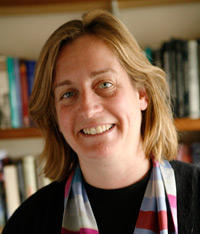
ABOUT
 Programme Director
Programme Director
Evelyn Welch, BA (Harvard) PhD (London)
Professor of Renaissance Studies and Vice-Principle, for Research and International Affairs, Queen Mary, University of London
Research Interests:
Italian Renaissance art and culture
Renaissance and Early Modern dress
Early Modern material culture
Evelyn Welch is an art historian with a special interest in visual and material culture in Europe between 1300 and 1700. She is the author of Art and Authority in Renaissance Milan (Yale, 1995), Art in Renaissance Italy, 1350-1500 (OUP, 2000) and Shopping in the Renaissance: Consumer Cultures in Italy 1400-1600 (Yale, 2005) which was awarded the Wolfson Prize for History, 2005. She is co-editor of The Material Renaissance (Manchester University Press, 2007) the result of a three-year Arts and Humanities Research Council and Getty Foundation funded project on Italian Renaissance consumption. She has recently completed a Wellcome Trust-funded study of a pharmacy, the Speziale al Giglio, in late fifteenth-century Florence with Dr James Shaw (University of Sheffied). Her current work focuses on dress and material culture; Professor Welch is now running an Arts and Humanities Research Council funded network exploring Early Modern Dress and Textiles in collaboration with the Victoria and Albert Museum and the Textile Conservation Centre, University of Southampton.
She is the director of the 5.5 million pound Arts and Humanities Research Council strategic programme, Beyond Text: Performances, Sounds, Images, Objects which runs until 2012. Professor Welch is Academic Dean of the Arts Faculty and was awarded a National Teaching Fellowship in 2005.
Recent Publications
Books
With Michelle O'Malley, The Material Renaissance, Manchester
University Press, Manchester, 2007.
Shopping in the Renaissance. Consumer Cultures in Italy, 1350-1600, Yale University Press, 2005.
Art in Renaissance Italy, Oxford University Press, 2000.
Selected articles and book chapters:
Between Italy and Moscow: Cultural Crossroads and the Culture of
Exchange' in Cultural Exchange in Early Modern Europe, volume IV, eds.
B. Roek and H. Roodenberg, Cambrige University Press, Cambridge, 2007, 59-99.
The Moaning Crucifixion: An Automata for Francesco Sforza, 1462, in Arte e storia di lombardia scritti in memoria di Grazioso Sironi , ed. P. Venturelli, Milan, 2006, 55-62.
Painting as Performance in the Italian Renaissance Court', in Artists at Court: Image-Making and Identity , 1300-1550, ed. S.Campbell, Boston. 2004, 9-18.
Public Magnificence and Private Display: Giovanni Pontano's De Splendore (1498) and the Domestic Arts, Journal of Design History, 15 (2002), 211-27.
The Art of Expenditure. The Court of Paola Malatesta Gonzaga in Fifteenth-century Mantua', Renaissance Studies , 16 (2002), 306-17.
From Retail to Resale: The Second-Hand Market in Renaissance Italy, 1400-1600' , in The Art Market in Italy, 15th -17th centuries, eds M. Fantoni, L. Matthew and S. Matthews Grieco, Olschki, Florence, 2002, 283-300.